
Index |
Next |
Prev |
Mr Mars' Magic Canon
3:0pm, Friday, December 1, 2023
Current mood: calm ![]()
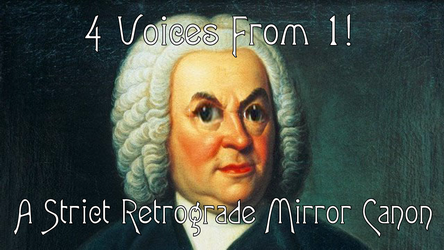
Bach opening his eyes on hearing my canon!
I'd been playing a lot of piano since I returned from my caravan adventures in WA and composing a bunch of classical pieces. One of those pieces was my piano adaptation of Bach's famous Chaconne in D minor. I know that various other people have done this already but not like mine they haven't! Anyway, matching wits with the great Johann Sebastian is not something to be taken lightly and one really has to immerse oneself in his work for quite some time in order to do him justice. The Chaconne deserves it's own entry so I won't discuss it here.
Anyway, I was watching a YouTube video on Bach's famous Triplex Canon where he has 3 parallel inverting canons that generate another 3 voices producing 6 in total. Quite a clever but rather limited musical exercise with a lot of repetition. Anyway, I thought: I wonder if I could do that? So I wrote 3 parallel melodies that generated another 3 by reversing, ie 3 parallel crab canons. It turned out pretty well but even before I finished that began thinking: I wonder if I can do a canon that works backwards AND inverted, generating 4 voices from 1! I don't know whether anyone else has done this but I was unable to find any examples on YouTube nor on the web.
![]()
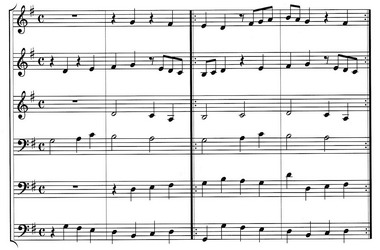
Bach's Triplex canon deciphered
Now there are various canon types that are closely related to what I have done but they are not exactly the same.
Bach's triplex canon uses inversion but not STRICT inversion which requires each interval above and below the pivot note to be a reflection exact to the semitone! A STRICT inversion means that many chords are not possible as their inversion will introduce discords. Similarly, many melodic notes will clash in STRICT inversion with many chords you might be intending to use.
Bach also delays his canon by a bar which makes it much easier to create a harmonious ensemble. An inverted canon that does not delay is called a MIRROR canon or a canon by contrary motion since the 2nd voice must by definition do the opposite of the first. When the first goes up it must go down and vice versa.
Bach also wrote a few TABLE canons which are canons that are retrograde and inverted around B4 on the treble clef so that they can be read equally by two players at each side of a table. These are not STRICT inversions however and they are only 2 voices.
Naturally I decided to embrace the challenge of using strict mirror canon that reverses at the end. No delays. 4 voices from 1! I guess you could call it a "strict retrograde mirror canon in 4 voices". Tricky!
![]()
Poles Of Symmetry
Not many people know this but the major scale has 2 poles of symmetry: about the major 2nd and about the augmented 4th above that. If you reflect any note from the major scale about either of these 2 notes the result will always be in the same key.
![]()
Before we go any further many of you may be wondering about the augmented 4th, (aka the tritone), and what makes it so special. Well I'll tell you: It's half an octave! It spans 6 semitones and the octave spans 12 so it's EXACTLY half. This means that if you change key by a tritone you instantly jump to the opposite side of the Circle Of 5ths. This means that you have switched to the key most remote from the original. Because certain aspects of the mathematics of music are symmetrical and much of it works in a circle, things will often work when you look at them from the other side of the circle. So, for example, notes that remain in key after being reflected about C will also stay in key when reflected about Gb because those two notes are half an octave apart which means that they are opposites on the circle.
In order to make my canon easy to view I decided to write it in Bb and reflect it about the 1st pole of symmetry, ie the major 2nd: middle C, so that everything in key would stay in key after reflection. Furthermore, because everything is reflected about middle C the treble clef is an exact reflection of the bass clef, provided you are careful with how you write the accidentals. Because when you go up on one side you need to come down on the other side, accidentals must be written in opposing notation, so an F# in the treble must be written as a Gb in the bass, (and vice versa), if you want to maintain perfect visual symmetry. For the purposes of ease of playing however it is best to use the same notation for both notes and this is why I have not done this in my manuscript. You can easily do it yourself though if you want to check the point.
![]()
Planning The Canon
Since the treble clef is a reflection of the bass clef. I just needed to write the first part in the bass clef and invert it to get the part in the treble clef. These two parts are then reversed to give the other two parts so we end up with 2 soprano voices and two bass voices.
Since music is symmetrical and circular, everything that works in Bb also works in E since it is the opposite key in the circle of 5ths. Note that F#, (aka Gb), is also the major 2nd in that key. Because of this bipolar aspect of the system I decided that it was desirable, nay, essential! to change key during the canon. So I set on 8 bars of Bb then 8 bars of E which will then reflect about the time axis to give 8 bars of E finishing with 8 bars of Bb. A total of 32 bars, leaving room to move ideas around a bit and to allow for 2 key changes. Nice!
![]()
Although the piece is putatively in 32 bars it is really only the first 16 bars that stand alone. One must understand that the combined voices from the first half will always be the reverse of the combined voices from the 2nd half for the following reason: Let's say a crab canon is 16 bars long, then the first part you write for the 8th bar will come back in reverse in the 9th bar. Similarly the part you write for the 9th bar will have already been played in reverse in the 8th. The combined parts for the 8th bar are thus the reverse of the combined parts for the 9th. You should be able to see from this that the combined 2nd half is just the reverse of the 1st.
Thus it is that this canon is not only a strict reflection about middle C it is also a strict reflection about the end of bar 16: A reflection in linear time as well as in logarithmic frequency.
![]()
The Essentials Of Inversion Harmony
Now here is a quick lesson on strict inversion in Bb with the pivot point being middle C: Bb becomes D, A becomes Eb, G becomes F and C remains the same. For notes outside the key: B becomes C#, G# becomes E natural and F# remains the same.
Let's try and make some chords: You can't make a simple Bb as although you can have Bb and D, when you add the F you also get the G, giving you Gm7. You can't make a simple F because F gives you G. C is unchanged and A brings Eb so you end up with F79. You can't make Eb because it brings A natural which doesn't fit. It does allow for C diminished 7th however as both C and Gb are available unchanged. You can't use Cm as Eb brings A natural and you wind up with C diminished again. You can't use Dm as the D brings a Bb, the F brings a G and you wind up with Gm7 again.
Thanks to the symmetry of the opposite pole we also get all the analogous chords from the key of E. There are only two chord shapes that don't fit either key and they are the C diminished 7th (which is also F# diminished 7th) and the two augmented triads: C+ and F#+.
Note that in the key of E the symmetry is displaced by one line. This is because having 4 sharps moves most notes down a line. If you don't change the key signature for the middle 16 bars you will see the symmetry perfectly maintained, but you will be dealing with a lot of accidentals...
![]()
So the composer is stuck with a VERY limited palette of chords:
From the key of Bb: Gm7, F79, part of Bb and part of C4.
From the key of E: C#m7, B79, part of E and part of F#4.
Outside the key we have C dim, C+, F#dim and F#+.
All in all these aren't the greatest chords to work with and it was a real struggle to make anything tolerably musical within these restrictions, still the key change was a blessing in this regard and a breath of new light when it comes in announced by the composer's friend: the diminished 7th. I didn't find a good use for the clashing sound of the augmented triad so I left it out. The same goes for the partial 4th chords.
![]()
The Source Voice
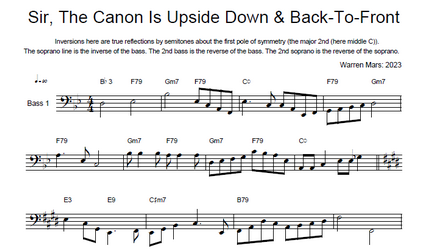
The source voice (click on it for the full score).
So here is the first voice that generates the other 3. On it's own it's not particularly musical and you would have to be a decent singer to nail this somewhat unnatural line. It hard to imagine that it will turn into nice 4 part harmony but believe me: it is the well-spring from which all the rest will come.
![]()
Here is an mp3 of my crappy Microsoft midi synth playing it.
All 4 Voices
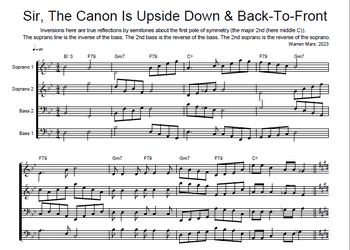
All 4 voices (click on it for the full score).
Here the 1st voice (Bass 1) is reflected about middle C generating the first soprano line in the process. The other 2 are parts obtained by adding the Bass 1 and Soprano 1 parts in reverse. As you can hear, the sound is much richer and if you listen closely it even becomes interesting and musical. If you don't listen that closely you will probably be dismiss it as 20th century junk...
Note that these parts require a wide singing range of almost 2 octaves and very accurate pitch so this is probably a job for professionals only.
![]()
Here is an mp3 of my crappy Microsoft midi synth playing it.
Piano Reduction
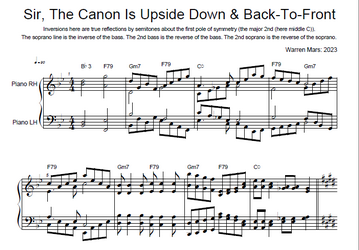
All 4 voices (click on it for the full score).
Not all of us have access to a professional vocal ensemble so here is a piano reduction of the same thing. It's rather weird but quite enjoyable to play in my humble opinion and certainly good practice for your contrary motion. Hopefully you will agree after trying it!
![]()
Here is an mp3 of my crappy Microsoft midi synth playing it.
4 Voice Choir With Piano Accompaniment
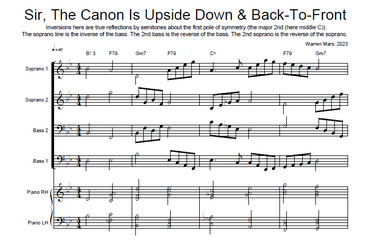
4 voices with piano accompaniment (click on it for the full score).
Finally, most choral pieces are not complete without an accompaniment. So here is the full score of the 4 voices with a piano accompaniment which is in itself a parallel, strict retrograde mirror canon. Excelsior!
![]()
Here is an mp3 of my crappy Microsoft midi synth playing it.
And there it is people! I hope you enjoyed it. It was tricky to create and took me a good 10 days as I had to rethink it a few times. The final rethink happened after I had already finished making my video of the first version and I realised I had left a chord out and needed to employ a key change and double the length. I had to restart almost from scratch!
I'm happy with how it turned out. It is 4 voices from 1 under VERY strict conditions! Those strict conditions however produce a special music with a perfect symmetry that you can't find elsewhere. A unique dish for the educated palette!
![]()
Currently watching: Anime
Shangri-La Frontier by Katarina, C2C